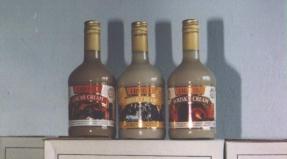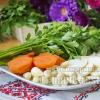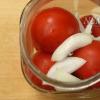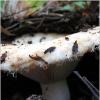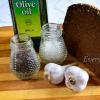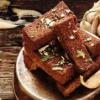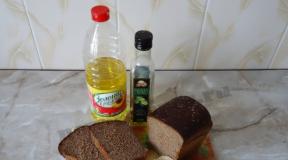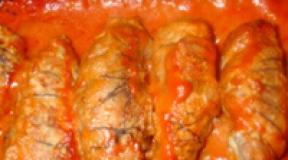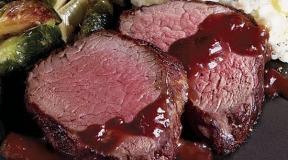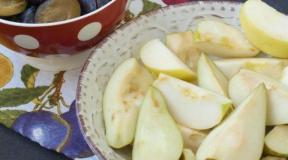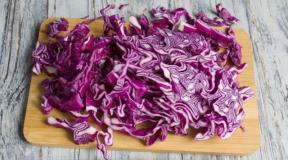The most delicious ice cream in the world. Do you know why Soviet ice cream was considered the best in the world? The most delicious and correct ice cream in the world
Summer- Why not go on a tour of world-famous gelaterias for the most delicious and unusual ice cream, to taste a molecular delicacy or prepared according to the most ancient recipes, exclusively from natural products. Who and when was the first to invent ice cream- it is impossible to establish - but in any case, it appeared many, thousands of years ago, when they came up with the idea of watering snow or crushed ice with sweetened juice.
Italy
Recently, pizza-flavored ice cream has appeared in Naples. An unusual dessert is creamy ice cream, wood-fired dough pieces with basil and tomato confiture. The culinary masterpiece with the taste of Italy is currently sold only in 5 Neapolitan establishments, however, in the near future, the number of outlets for selling this unusual delicacy is planned to be expanded.
Today, the total number of gelaterias in Italy is incalculable. And there is nothing surprising that the first museum dedicated to ice cream was opened here, because ice cream is considered to be an original Italian delicacy. It was the Italians who invented the waffle cone so that ice cream could be eaten right on the street.

Carpigiani Museum is a gallery, a workshop, a school and a university in one place. The modern light space for the cafe-museum was provided by the famous Italian plant Carpigiani, which produces ice cream machines. Museum visitors can not only try everything, but also invent ice cream to their own taste. Excursion, tasting and master class on cooking homemade Italian ice cream are available only by appointment.


The oldest ice cream parlor in Rome is considered to be a shop Giolitti in existence since 1890. -At first it was a dairy shop on Sali-ta del Grillo, opened by the married couple Giuseppe and Bernardina Giolitti near the Pantheon. And only some time later Giolitti moved to via Uficci de l Vicario, where they began to sell not only milk, but also ice cream. And to this day, ice cream is sold here by the descendants of this glorious family couple.
Bearing the Giolitti surname many times rejected offers to sell the brand or transfer it to the management of some large corporation, and only once agreed to open a Giolitti branch in the EUR business center (Esposiz-ione Universale Roma) on outskirts of Rome.
This place has been considered the city's "gelateria" No. 1 since 1953, after the release of the film "Roman Holiday", in which Gregory Peck treated Audrey Hepburn to a waffle cone bought here. Giolitti's signature varieties include champagne-flavoured ice cream, Sicilian k-assata, marsala and rice. In the cafe itself, you can order historical desserts with ice cream: for example, Coppa Giolitti made from chocolate ice cream, grated hazelnuts, whipped cream and zabaione according to a 1920 recipe and Coppa Olimpica in the form of an Olympic torch, invented for opening of the Olympic Games in Rome in 1960.

France
The most famous Berthillon ice cream parlor is located on the Ile Saint-Louis, just 300 meters from Notre Dame Cathedral, located on the neighboring Ile de la Cité. The cafe has been operating since 1954 - then it was a family shop. Today, ice cream is sold in another 20 mini-points on the island, but there are always queues in the main store. At the same time, the shop usually closes for two weeks in August. According to legend, the Bertillon family owns the secret of whipping cream, so the ice cream turns out to be especially delicate in taste.
B-ertillon serves more than 70 varieties of sorbets and ice cream: with kiwi, passion fruit, melon, rhubarb.One of the popular varieties is chestnut. And among the most outstanding options-
ice cream with plums in Armagnac, with ginger caramel, almond milk, candied chestnuts, lemon-coriander praline, cocoa with whiskey and raspberries with roses. Among the original recipes-
foie gras ice cream. Popular varieties are also present - vanilla, chocolate and strawberry from the freshest strawberries, fruit with seasonal fruits, with milk and cream from Normandy farms.

Great Britain
The most famous brand of ice cream in England, Morellis Gelato, owned by the Neapolitan family of Morelli. You can try it on the first floor of the fashionable London department store Ha-rrods. This ice cream dates back to the beginning of the 20th century, when Giuseppe Morreli, who emigrated from Naples, and his son, sold these desserts from his bicycle. Londoners loved ice cream so much that they had to open a store. Incidentally, until 2001, the Morreli store was the official supplier of the British Royal Court. Among the original varieties- ice cream flavored with apple pie, Sicilian red oranges and Christmas pudding. But the main feature is that here you can order and make author's ice cream from almost any ingredient. Although with the taste of pearl barley with cucumbers. According to the owners, they have already made pear and gorgonzola ice cream, with white chocolate and Piedmontese truffles, and with pickled onions. The most unusual orders were ice cream flavored with Marmite paste, which in Britain is smeared on bread (a salty concentrate of brewer's yeast), and haggis (a traditional Scottish dish of lamb giblets with onions, lard and oatmeal, boiled in a lamb's stomach). You can order original ice cream 48 hours in advance, minimum order- one litre.


molecular ice cream-
When preparing molecular ice cream, the prepared mixture is poured with liquid nitrogen and balls are formed. The liquid freezes instantly - ice crystals do not have time to form in it and the ice cream turns out to be unusually tender, literally melting on the tongue. In addition, "molecular ice cream" does not need traditional thickeners like milk fat - it can be completely unsweetened and completely non-greasy and made from, in general, anything. Including from ingredients from which it is practically impossible to make ordinary ice-cream. Molecular ice cream must be eaten literally within a minute of p-after preparation, otherwise it will simply turn into a puddle.
The first molecular ice cream was “invented” by Heston Blumenthal, the owner and chef of the restaurant fat duck in the county of Berkshire in the south of England. Blumenthal, awarded as many as three Michelin stars, looked for and found a way to surprise his visitors. Fat Duck serves mustard ice cream with red cabbage gazpacho. Another kind of ice creamFat duckconsists of two parts: a tiny cone with bergamot ice cream itself and a pretty dessert with macerated strawberries.



AT Chin Chin Laboratories the technology is the same: ice cream is poured with liquid a-zot right in front of the visitors. And the cafe itself is more like a scientific laboratory: there are solid retorts, beakers around, and the sellers in white coats (they are the owners) are a pleasant married couple. On the menu: tarragon and blackberry ice cream or basil with green tea, as well as traditional vanilla and lemon cheesecake.



Germany
In the typical Berlin cafe Caramello, there is an emphasis on everything healthy, organic and environmentally friendly, i.e. dyes, preservatives and additives with the E index are not used. Chocolate, vanilla and other exotic ingredients - which are not grown directly in Berlin - are ordered only from trusted suppliers. Yes, and the choice of products is approached very carefully, for example, cinnamon is bought only in Sri Lanka, where it is supposedly the most fragrant. Once upon a time, Caramello was a modest cafe with Sicilian recipes, which was famous for its caramel ice cream. Over time, they began to be more selective in the selection of ingredients, from which everything harmful and dubious was excluded. And now C-aramello ice cream is suitable for those who are allergic to gluten (it's all gluten-free), as well as vegans and people with lactose and milk protein intolerance. Actually, the entire Caramello menu is divided into two parts: with milk and without milk. The second option is made on the basis of soy milk or fruit purees.

resin ice cream
Ice cream, mixed with mastic, the hardened resin of wild pistachio trees, is found only in Turkey and Greece. Such ice cream is more viscous than we are used to, and melts more slowly. In the markets and in specialized shops, sellers even cut the balls picturesquely with an ax to demonstrate their hardness.
Greece
In Greece, this ice cream is called kaimak-i. It occurs quite often, but it is better to try it not in Athens, but in the town of Pagrati, for example, which is especially famous for it. Moreover, the Greeks themselves admit that the recipe for kaymaki was borrowed from the Turks, who make it even tastier. In Turkey, mastic ice cream is called dondu-rma.
Turkey
One of the best is the ice cream in the shop Mado, founded by immigrants from the province of Karamanmaras, where, as it is believed, dondurma was invented. Dondurma is often called “Marash ice cream”. In Mado, ice cream is made only with mountain goat milk (in other places - from buffalo), while they assure that the recipe is about three hundred years old. Ice-cream is served cut into pieces, eaten with a knife and fork. It is better to start the tasting with the Maras Cut variety, a simple milk ice cream without additives, since it is in it that the resinous taste of mastic is easily recognized. The ice cream balls familiar to us are also served in Mado, fig and chestnut ones are especially good.


In another famous Istanbul institution Ali Usta dondurma is made with the addition of "salep", a powder from the tubers of mountain orchids. There are 32 types in the assortment of the cafe "salepi dondurma": with mint, vanilla, pistachios, r-ohm, Turkish coffee, etc.

Singapore
In Singapore, ice cream prepared according to special recipes can be tasted in two places at once.
More than a hundred varieties of ice cream are prepared in the cafeteria Toms Pallette, and most of them you won't be able to find anywhere else. Among the unique varieties- ice cream with oolong, ginseng, lime and wasabi, black rice, lemongrass and sauvignon blanc, tofu with plums, chrysanthemum, apple curry or caramelized onions. For Christmas, ice cream is prepared here with chocolate pudding with the addition of chestnut brandy, as well as osmanthus.

In theory, the name of the cafe " Udders» («Udder»), should evoke associations with natural products and rural landscapes. The highlight are varieties with the addition of alcohol. For example, "Rum - & Raisins" with a double portion of rum, "Baileys - & Bourbon", "Black Amaretto" and Choya Lime Umeshu Sorbet based on Japanese plum tincture. The café's motto is "Three scoops of our ice cream is like one mug of beer!". In the Java Whiskey Choc recipe, whiskey is combined with dark chocolate. There is also gula melaka flavored ice cream.- Indonesian palm sugar and tender, immature mangrove fruits, and chempedak ice cream, the fragrant cousin of jackfruit and breadfruit. But the main place on the menu is occupied by two varieties of durian ice cream- smelly and very smelly.


Japan-
Score Cup Ice Museum in a giant shopping mall in Tokyo, Sunshine City is more like a museum and impresses with a huge number of ice cream varieties. The main supplier of milk is the island of Hokkaido, famous for its dairy farms. The range of other components is amazing. There is ice cream made from veal tongue, potato, octopus, squid, and seaweed, with the taste of ramen (noodles in pork broth) and mackerel pike, with whale meat, lettuce, garlic, shrimp, sea salt and chicken . And a separate place is occupied by alcoholic ice cream- with the taste of various varieties of sake, beer and rice vodka sethu. There are also flavor combinations: vanilla and octopus, pumpkin and squid, watermelon and shark fin, banana and wasabi. Cup Ice Museu-m sells about 400 mixes, one better than the other.


India-
Making ice cream according to the original recipe is a very laborious task. Perhaps the most difficult thing to cook is Indian kulfi, because it is prepared from milk that has been evaporated by about half by boiling in a metal bowl, while the milk-o must be gently stirred so that it does not burn. Evaporated m-milk becomes fatter, thicker and sweeter. Then the mixture is frozen (previously, disposable clay pots - kulhars) were used for this. The institution does an excellent job of preparing kulfi ice cream Badshah Kulfi(Mumbai, India).


Kulfi is a dense and sweet dessert reminiscent of creme brulee-flavoured frozen pudding. Ready kulfi is seasoned with crushed pistachios, cardam-on, saffron or rose water. It is often served with rose syrup, sweet clear and falude vermicelli, and lime juice. Kulfi in pots is less and less common, now it is usually sold on a stick wrapped in foil.
You can usually find a simplified version of kulfi made from condensed milk, cream and starch. That is why the public appreciates Badshah Kulfi, an institution with a hundred-year history, where kulfi is made according to all the rules.
USA
The natural ice cream market in the US is so large that it is very difficult to distinguish yourself.
For example, an establishment Pazzo Gelato from Los Angeles, offers more than 100 varieties of ice cream, handmade from natural ing-redients. All components are bought only at the local farmers' market. The variety of varieties is amazing. There are about twenty varieties of one w-cook ice cream, from martini or pear chocolate to smoked chocolate and salted chocolate. Moreover, each variety can be made to choose from Venezuelan chocolate (72%), Peruvian (65%), Madagascar - (64%) and very bitter 91% Dominican. There is even sugar-free chocolate ice cream. Other varieties include Guinness beer ice cream, avocado with pepper, spicy pumpkin, goat cheese with figs, bergamot with lavender, persimmon, yellow watermelon and cactus flowers.

Institution Bierkraft Brooklyn is famous for its ice-cream burgers. This is practically the same as a regular burger, only inside the bun, instead of a cutlet and cheese, there is a layer of vanilla ice cream. Such burgers are served here as a beer snack, and as many as 1,000 beers are presented on the local menu.

Lebanon-
Once in Baghdad, Beirut, Damascus and Cairo they made the best ice cream in the world. Somewhere they make it now- for example, in a cafe in Beirut Hanna ice cream, unremarkable in appearance. However, this café is over 50 years old and has been run by the same hand-made ice cream family all this time. At the same time, recipes and equipment did not change. At the Hanna Ice Cream Cafe in Beirut, ice cream is made according to a traditional Arabic recipe.- on milk, without the addition of cream and eggs, thickened with salep, i.e. powdered tubers of wild orchids. These tubers contain gluco-mannan, thanks to which ice cream is semi-viscous like dough. Hanna's classic ice cream is pistachio, for which the pistachios are hand-selected and crushed. Popsicles are made only from seasonal fruits, bought exclusively from the local market. Halab-i ice cream made from peanuts, almonds and chocolate is considered to be a specialty. There is no skill in ice creamctvennye additives. In winter, biscuits made from dates, pistachios, walnuts and something like turmeric buns are added to the assortment.


Venezuela
ice cream parlor Heladeria Coromoto-- the world record holder with the largest assortment of ice cream, recorded in the Guinness Book of R-Records: more than 800 flavors! The institution is located in the city of Merida in an inconspicuous-looking one-story yellow house. Natural avocado, pumpkin, cheese, squid, champagne and much more are added to ice cream. A special pride of the establishment is metallic ice cream containing Viagra, the effect of which is enhanced by honey and bee pollen included in the recipe.

June 10 - World Om-nom-nom Day! I mean, World Ice Cream Day. There is no doubt that this is one of the most important holidays of the year, and, of course, you need to spend it with a portion (or even more than one) of your favorite dessert. We propose to find out in which countries they make the most delicious ice cream in the world.
Dondurma
Connoisseurs of dondurma say that visiting Turkey and not trying a local dessert is unforgivable stupidity. This dessert is sold from street carts, and vendors often put on a real show, teasing customers before giving away a portion of dondurma. Just look at this!
Gelato
Undoubtedly, one of the best ice cream varieties in Europe is made in Italy. This creamy and dense dessert melts slower than regular ice cream due to its low air content. Each master makes gelato with its own taste and smell, so when you are in Italy, try it in all the gelaterias you see! And don't forget to sing gelato-chocolato while doing it!
Previous photo 1/ 1 Next photo


frozen yogurt
To be fair, Greek frozen yogurt is not exactly ice cream. But this is a very tasty sweet-cold dessert, which you should definitely try when you arrive in Greece. Sweetness is sold in special shops, which, in addition to yogurt, have a bunch of additives: from berries and fruits to muesli and sweets.
Previous photo 1/ 1 Next photo


molecular ice cream
An extremely unusual dessert was invented by the British kitchen alchemist Heston Blumenthal. Molecular ice cream is prepared on liquid nitrogen and exists in solid form for only a few minutes, after which it spreads on a plate in a fancy colored puddle. Tastes of goodies can be very different.
The good news is that you don't have to shell out for a trip to the UK to try unusual ice cream. The dessert has become so popular that it can now be found in many cities around the world.
Previous photo 1/ 1 Next photo



In the world ranking, 6 places out of 10 went to Unilever brands, 2 positions went to Nestle brands, General Mills and Wells "Enterprises got one place each. The overall ranking of the 10 largest ice cream brands is as follows:
1. Magnum (Unilever Group)
3. Cornetto (Unilever Group)
4. Ben & Jerry's (Unilever Group)
5. Breyers (Unilever Group)
6. Carte D'or (Unilever Group)
7. Dreyer's/Edy's (Nestle SA)
8. Blue Bunny (Wells Enterprises)
9. Drumstick (Nestle SA) 10. Kibon (Unilever Group)
In the Asia-Pacific region, transnational brands also made it into the ranking: Unilever's Cornetto and General Mills' Haagen Dazs took 2 positions. The top also included 2 brands of Inner Mognolia Yuli Industrial Group. Another 4 trademarks in the ranking belong to the Japanese companies Meji, Glico and Lotte.

1. Cornetto (Unilever Group)
2. Haagen Dazs (General Mills Inc)
3. Yili Chocliz (Inner Mognolia Yuli Industrial Group)
4. Meiji (Meiji Holdings Co Ltd)
5. Glico (Ezaki Glico Co Ltd)
6. Lotte (Lotte Group)
7. Sanquan (Zhengzhou sanquan food)
8. Wall's (Unilever Group)
9. Yili (Inner Mognolia Yuli Industrial Group)
10. Synear (Synear Food Holdings Ltd)
In Oceania, the TOP-10 includes well-known brands of international companies: 4 out of 10 positions have gone to the Unilever Group. It is noteworthy that the rating includes R&R Rice Cream, which recently launched a joint business with Nestle.

1. Peters (R&R Rice Cream)
2. Magnum (Unilever Group)
3. Bulla (Regal Cream Products)
4. Tip Top (Fonterra Co-operative Group)
5. Sara Lee (Tyson Foods)
6. Blue Ribbon (Unilever Group)
7. Connoisseur (Nestle SA)
8. Paddle Pop (Nestle SA)
9. Cadbury (Mondelez International)
10. Ben & Jerry's (Unilever Group)
In Eastern Europe, 3 brands in the top 5 are owned by Unilever. The remaining positions went to regional market players. Rud, Laska and Lasunka are brands of Ukrainian dairy companies, Frikom is the leader of the Serbian market, Koral is a Polish trademark. La Fam ice cream is produced by the Russian company Talosto, the Ledo brand belongs to a manufacturer from Croatia.

1. Golden (Unilever Group)
2 Algida (Unilever Group)
3. "Rud" (Zhytomyr creamery)
4. Magnat (Unilever Group)
5. Frikom (Agrokor dd)
6. "Lasunka" (Lasunka)
7. Koral (PPL Koral)
8. La Fam (Talosto)
9. "Laska" (Firm "Laska")
10. Ledo (Agrokor dd)
The Latin American market is once again dominated by the Unilever umbrella brands, occupying the top 4 positions in the ranking. Other transnationals can also be seen in the TOP: Nestle and General Mills.

1. Kibon (Unilever Group)
2. Magnum (Unilever Group)
3. Cornetto (Unilever Group)
4. Tio Rico (Unilever Group)
5. EFE (Empresas Polar)
6. Nestle (Nestle SA)
7. Crem Helado (Grupo Nutresa SA)
8 Savory (Nestle SA)
9. D'onofrio (Nestle SA)
10. Haagen Dazs (General Mills Inc)
In the Middle East and Africa market, international companies, Unilever and Nestle, are represented by 4 positions out of 10. Mihan, Domino, Kalleh, Daity, Pak are Iranian companies, IFCO is a manufacturer from the UAE.

1. Mihan (Mihan Dairy)
2. Domino (Domino Dairy & Ice Cream)
3. Kalleh (Solico Food Industrial Group)
4 Magnum (Unilever Group)
5. Kimo (Nestle SA)
6. Extreme (Nestle SA)
7. Daity (Zarrin Ghazal)
8. Pak (Pak Dairy)
9. Dolceca (Nestle SA)
10. Igloo (IFFCO)
The TOP 10 ice cream brands in the North America region are mainly represented by multinational companies. The exceptions are Blue Bunny by Wells' Dairy and Bluebell by Texas-based Blue Bell Creameries.

1. Breyers (Unilever Group)
2. Haagen Dazs (General Mills Inc)
3. Ben & Jerry's (Unilever Group)
4. Dreyer's/Edy's (Nestle SA)
5. Blue Bunny (Wells' Dairy)
6. Klondike (Unilever Group)
7. Drumstick (Nestle SA)
8 Outshine (Nestle SA)
9. Popsicle (Unilever Group)
10. Blue Bell (Blue Bell Creameries)
In Western Europe, history repeats itself: the majority of ranking positions belong to international companies. The last 2 lines are occupied by trademarks of companies from Germany.

1. Magnum (Unilever Group)
2. Cornetto (Unilever Group)
3. Carte D'or (Unilever Group)
4. Haagen Dazs (General Mills Inc)
5. Viennetta (Unilever Group)
6 Ben & Jerry's (Unilever Group)
7. Movenpick (Nestle SA)
8. Solero (Unilever Group)
9. Coppenrath & Wiese (Conditorei Coppenrath & Wiese)
10. Bofrost Bofrost Dienstleistungs (GmbH)
Ice cream is one of the few foods in this world that almost everyone loves. It's great to enjoy a cool dessert on a hot summer day or add a scoop of ice cream to fragrant hot coffee on a winter evening. Among the huge variety of ice cream, there are truly exclusive varieties that are definitely worth a try if they come into view.
1. Taco 
California ice cream shop Sweet Cup has created an unusual sweet dish - taco ice cream. The only way it differs in appearance from real tacos is that it is very bright and colorful.
So, what is sweet taco made of. Inside it, instead of meat filling, the most common ice cream. And instead of a tortilla in which the filling is wrapped, Sweet Cup uses a soft waffle. The ice cream is then garnished with edible gold, sprinkles of chocolate syrup, and fizzy candies that mimic the salad and sauces commonly added to tacos.
2. Kakigori 
Kakigori is a popular Japanese dessert made from small ice chips flavored with syrup. It first appeared in Kanagawa Prefecture in 1869. Common flavors include strawberry, cherry, lemon, green tea, grape, melon, sweet plum, and colorless syrup. To sweeten kakigori, it is often doused with condensed milk. Kakigori is usually eaten with a spoon.
3. Gelato 
I-Creamy Artisan Gelato offers one of the most delicious and beautiful ice creams in Sydney. And they make it in the form of stunningly beautiful flowers from gelato. Gelato is an Italian frozen dessert made from fresh cow's milk, cream and sugar, and berries, fruits, nuts and chocolate are also added to it. Unlike regular ice cream, it has less fat but more sugar, and gelato is creamier and slower to melt.
4. "Macaron" 
If you combine the classic French pasta confection with ice cream, you get a sweet sandwich cookie with an ice cream layer. What makes it special, according to food journalist Jessica Yadegaran, is that the taste and texture of the ingredients complement each other perfectly. Such a “cookie” with ice cream costs about $ 5.
5. "Gothic" 
Those who are annoyed by colorful balls of ice cream can finally rejoice - there is a real ice cream, no different from the "regular", except that it is jet black. This toasted almond ice cream is made by Little Damage in Los Angeles and is darkened with activated charcoal.
6. Burrito 
The owners of a Sugar Sugar dessert shop in Sarnia, Ontario decided that if taco ice cream existed, why not make burrito ice cream. Wrap it instead of a tortilla in cotton candy.
7. "Galaxy" 
Galaxy ice cream is perhaps the most beautiful in the world. Instagram user Lee-Chi Pan posted photos of his masterpiece on the Web in 2016, but did not share the recipe for how he managed to achieve this.
8. Spaghetti 
It may look like a bunch of pasta, but it's actually ice cream. They do a similar miracle in Germany, and do not necessarily pour red sauce. Other variations exist, such as vanilla ice cream spaghetti carbonara served with brownish liqueur sauce and nuts.
9. Astronaut 
"Premium" non-melting ice cream.
It would be nice if on a hot summer day you could enjoy a nice refreshing ice cream that doesn't drip on your hands. Rob Collington, 34, founder of the Gastronaut ice cream company, has always been a big fan of the Astronaut ice cream sold in space museums and camping stores in the US.
He remembered that it was not very tasty, because it was made from the cheapest artificial ingredients, but at the same time it hardly melted. Rob ended up quitting his job as an office worker and spent three and a half years developing his own version of natural, organic ice cream that tastes good without melting.
10. "Luminescent" 
Charlie Francis of ice cream company Lick Me, I`m Delicious created this special ice cream for Halloween. This glow-in-the-dark ice cream was made using calcium-activated proteins that respond to external stimuli. Simply put, they glow when a person licks ice cream. Such a pleasure is not cheap - $ 200 per serving.
What is the phenomenon of Soviet ice cream, which many have admired since childhood?
It is debatable whether it exists or not. In fact, of course, we all remember the same ice cream. Before, after all, we didn’t have any other ice cream, except for creamy, milk, ice cream.
A pronounced milky taste is what distinguished Soviet ice cream.
Creamy, ice-cream, fruit and berry, wafer cups with cream roses, popsicle, chocolate-glazed cone… Here it is - the era of Soviet ice cream! Its quality was legendary. And yet, what is the secret of the unique taste?

We owe this to GOST 117-41, according to which we produced the favorite delicacy of Soviet children. It was considered one of the toughest in the world and was introduced as early as March 12, 1941. In the domestic "chill" there was not a single preservative, only natural milk! And all types of ice cream were produced according to a single technology. Therefore, the taste of dessert in any city of the Union was the same!
Initially, the Soviet authorities did not spoil ice cream with their attention and called it a product with a bourgeois flavor. Which could not but discredit him in the eyes of the proletarian public. Over time, the attitude of the government to the dairy delicacy “thawed out”, and after the war they began to popularize it in every possible way.

Soviet prices: ice cream with "swan" - 13 kopecks, milk - 9 kopecks, fruit - 7 kopecks, small chocolate "eskimo" - 11 kopecks, large - 22 kopecks, "Leningrad" chocolate - 28 kopecks, creamy with cream in a waffle cup a rose - 28 kopecks and an ice cream cake with cream.

For the first time, ice cream was put on industrial rails in the 30s. A decree was issued by the People's Commissar of Food of the USSR Anastas Mikoyan, who insisted that ice cream should become a mass food product and be produced at affordable prices. According to the People's Commissar, a Soviet citizen should eat at least five kilograms of ice cream a year! Added fuel to the fire and the fact that the United States has long held the palm in this matter. In America, 600 thousand tons of ice cream were produced, while in the USSR - only eight. It was decided to change the situation radically, and Mikoyan went to the USA to purchase the necessary equipment. Already on November 4, 1937, the first Soviet delicacy was produced in the USSR. Then refrigeration plants were opened in Moscow, Leningrad, Kharkov. In 1940, a powerful ice cream factory started operating in Kyiv.

We must pay tribute to the quality of products. Each batch of snow treats was evaluated on a 100-point system. Any deviation from taste, color or smell was considered a marriage. In addition, the time for the implementation of ice cream was limited to one week. (Now ice cream can be stored for about six months!) Thus, in terms of production and consumption of ice cream, the USSR came in second place in the world after the USA. Two thousand tons were exported annually. Abroad, Soviet ice cream was classified as a prestigious class. It was served exclusively in expensive restaurants at a far from “soviet” price.

At home, the most delicious ice cream in the world did not have time to stale - they were taken apart instantly. Sold by weight or packaged in 50 or 100 g on street stalls, kiosks or cafes. In the 50s, enticing posters hung on the streets, on which penguins flaunted with popsicles - a symbol of ice cream of the USSR.

A glass of "creamy" cost 22 kopecks, for another three you could take a filler - jam or grated chocolate. There was also a popsicle for 24 kopecks, but it was sold only at one point and very rarely. When ice cream was just brought in, it was collected in five or six packs at once, so that it would be enough for the whole family. An aunt in a colorful cap opened a metal container, and you chose the one you want. If the ice cream was over, the saleswoman said happily: “It will be in 2 hours” - or sadly: “Don’t take the queue,” and then everyone began to buzz indignantly.

Ice cream kiosks were infrequent, at best three times a week. Therefore, the queues were lined up serious. And how they scolded the people who came for ice cream from the villages! They filled them with three-liter jars, delaying the queue for a long time. Ice cream was sold in the cafe, it was put with multi-colored balls in ice cream makers with a spoon. There was also chocolate, creme brulee, fruit, champagne and even soda water with syrup or fruit sauce ...

For children in the villages, ice cream was a real miracle - it was not delivered to local stores. Therefore, they learned to make a scarce delicacy themselves: they kneaded snow in a mug, mixed it with sour cream and sugar. It turned out almost like the real thing, even if it looked unsightly.

Some types of Soviet ice cream were unique. For example, a waffle cup with a cream rosette on top or the famous Lakomka. We owe its appearance to the discovery of locksmiths, who in the 70s invented a special nozzle. With its help, the glaze began to be applied in a stream, and not by the “dipping method”.

There was also tomato ice cream, which many do not remember. But those who have tried it will never forget its taste. Some considered it a rare muck, others would like to turn back time to try again.
- "Tomato" was sold in a paper cup, with a stick to boot.
- The taste is unique. Too bad they don't release it now. It was cheap, only 10 kopecks. Well, if a penny was not enough, it happens that you dig the apartment upside down, turn out all your pockets, and you can run for ice cream!

Ice cream "Kashtan" for 28 kopecks was considered the real booty - the price equal to nine trips on the tram!
- Fruit ice cream was not considered at all.
- The highest measure of pleasure was a rare "Chestnut". What kind of chocolate was there - you can’t pull it by the ears! Not like now: you take a bite - and all the chocolate crumbles like needles from a dry Christmas tree.

The decline of Soviet ice cream came with perestroika. And since 1990, the country has been covered by a stream of imported ice cream with a clearly chemical filler. The taste of real Soviet remained in the memories of older generations.


